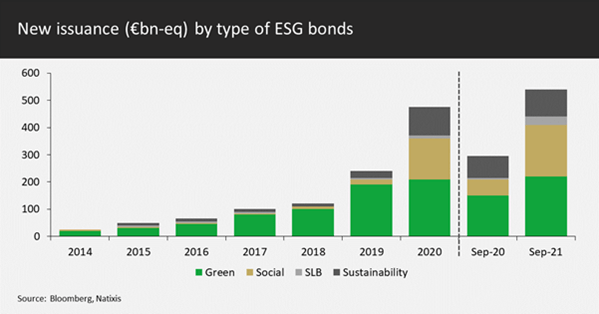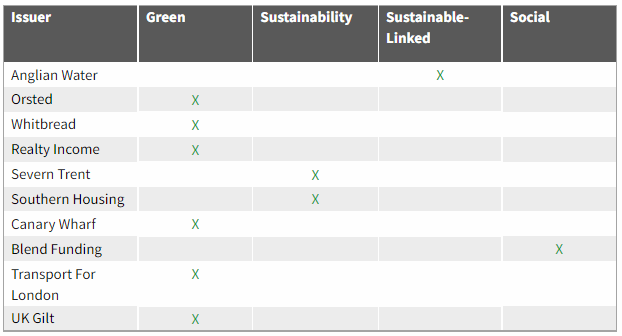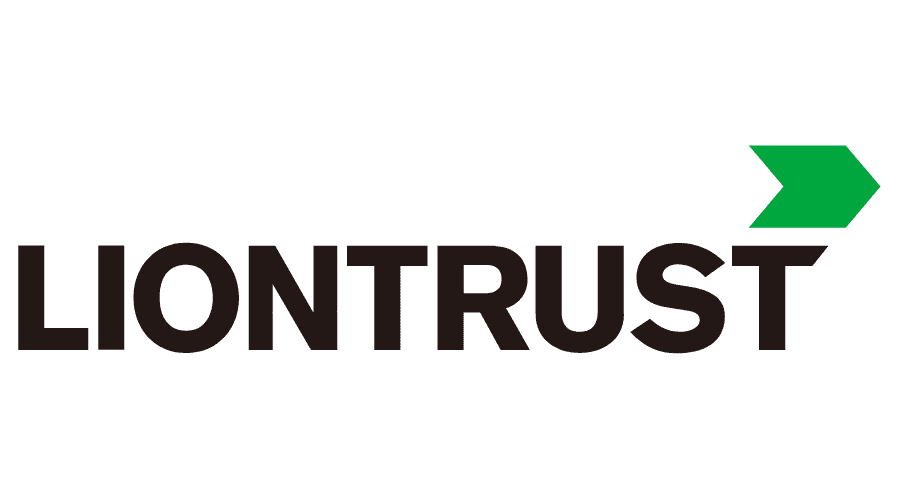2021 saw significant growth in the market for green and sustainable bonds, driven by regulation, environmental targets and increasing investor demand.
From an issuer’s perspective, these bonds offer scope to broaden their investor base, demonstrate their commitment to sustainability credentials and potentially access better pricing. As the chart below shows, we have already seen a significant surge in sustainable bonds in recent years, with an acceleration of this trend in 2021. For the nine months to the end of September, supply was almost twice that of 2020 and increased by 17% in the third quarter compared to the same period a year earlier.
Sustainability-linked bonds are experiencing the highest growth rates, with the €18 billion issuance in Q3 2021 almost six times the level of the previous year. New research from Pictet and the Institute of International Finance suggests global issuance of environmental, social and governance (ESG) bonds could reach $4.5 trillion a year by 2025, with fixed income markets needed to help raise some of the $4 trillion of capital required annually just to contain the threat of climate change.

In the UK, green bond supply figures rose sharply last year, although this is mainly due to the one-off effect of the UK Treasury issuing an inaugural green gilt. In this article, we cover the various different types of ‘sustainable’ bonds as well as their potential benefits and drawbacks, and how we are accessing these trends for the Liontrust Sustainable Future funds.
1. Sustainability-linked bonds (SLBs)
These are bonds for which issuance proceeds are not ring-fenced for green or sustainable purposes (unlike ‘use of proceeds’ green or sustainable bonds) and may also be used for general corporate or other projects. They are guided by the sustainability-linked bond principles, although these are voluntary and only constitute best practice. Similar to green bond principles, these are designed to promote integrity and transparency in the sustainable finance sector:
- Selection of Key Performance Indicators (KPIs)
- Calibration of Sustainability Performance Targets (SPTs)
- Bond characteristics
- Reporting
- Verification
With these bonds, issuers are committing to improvements in sustainable outcomes within a predetermined timeline; if they fail to achieve pledges, the coupon typically steps up by 25 basis points as a penalty. As examples, retailers such as Tesco, H&M and Ahold have all issued SLBs with targets such as reducing carbon intensity, increased recycling of textile materials and cutting food waste, while the Italian utility Enel released a US$ SLB connected to having renewable energy accounting for 55% of its installed generation capacity by the end of 2021. Kerry Group, meanwhile, issued an SLB linked to both food waste and carbon emission reductions; interestingly, its coupon step ups are 50bps per KPI as a penalty.
In terms of benefits, SLBs provide an opportunity for more issuers to access the sustainable bond market, including those in sectors/activities that are challenged from an ESG standpoint or have low capex requirements. They reflect a commitment at issuer level – whereas green and social bonds tend to be more focused at the project level and use of proceeds – with pledges to making long-term sustainability changes to their business model. These bonds also offer greater flexibility as they can be used for general corporate purchases, re-financing and acquisitions.
As for disadvantages, timing of any coupon penalty can be in the last year of the bond’s maturity and step ups are typically not large enough if issuers fail to meet their promises.
We continue to rate issuers from an overall ESG perspective, so even if KPIs are linked to environmental improvements, we will be unable to participate in the bond if an issuer is uninvestable. In the case of Tesco, for example, this is uninvestable as the company breaches our limitation on 5% of revenues being derived from the sale of tobacco.
2. Green bonds
Our view has always been that just because a bond is green does not mean it will be a good investment. Success measured in coupon and capital repayments depends on the financial health of the issuer and our investment decision for these is based on the same process as for conventional instruments.
From a credit investor’s standpoint, there is no difference between green and conventional bonds: the green classification does not change the risk profile as this is driven by the underlying credit quality of the issuer.
Considerations in this area include the following:
- Use of proceeds: which should be designated for green projects.
- Process for project evaluation and selection: issuers should provide transparency of the project’s sustainability objectives and process.
- Management of proceeds: which should be held in a distinct sub-account and tracked throughout the life of the project, with a high level of transparency for investors.
- Reporting: should be kept up to date and readily available, describing the amounts allocated to the projects and the expected environmental impact.
The unique structure of green bonds can be a cause for concern. Although the proceeds are used for green projects, the debt is serviced by the issuing firm as a whole, with coupon and principal repayments made by the overarching entity. EDF, for example, has several green bonds outstanding, with proceeds allocated to renewable energy projects complying with International Capital Markets Association (ICMA) principles. These bonds are financed by EDF as a firm, however, which also has considerable exposure to nuclear and coal energy.
Bank of England – greening of corporate bonds
As part of the UK’s overall net zero goals, the Bank of England has announced a reinvestment programme for its corporate bond purchase scheme, the first central bank to declare such a measure. The scheme was introduced in 2016 and purchases investment grade sterling corporate bonds issued by companies judged to make a material contribution to UK economic activity. The BoE’s aim is to lower its carbon footprint by focusing on reducing the tonnes of CO2 per £million revenue of this portfolio, with a target of a 25% cut in carbon intensity by 2025 to align to a net zero by 2050.
Companies will now need to satisfy climate-related eligibility criteria for their bonds to be purchased, with the scheme tilted towards stronger climate performers within sectors. The extent of this tilt will be assessed against four metrics: emission intensity of activities, progress in reducing emissions, publishing a climate disclosure, and having an emissions reduction target (with more credit if this is third party verified). Requirements are expected to escalate over time and the Bank can take action against weaker performers, including reduced purchases, removal of eligibility or even divestment.
Green gilts
The UK priced its first green Gilt in September 2021, with a 12-year maturity and a £10 billon issue size. The order book was around £100 billion and eligible areas are limited to government expenditures that occur no earlier than 12 months prior to issuance, the budget year of issuance and the two budget years following issuance. HM Treasury will report on the social benefits of the expenditure as well as the environmental impacts every two years and proceeds can be used for six categories: clean transportation, renewable energy, climate change adaptation, energy efficiency, living and natural resources and pollution prevention and control.
Over the third quarter of 2021, we switched a large part of our Gilt allocation in the Liontrust SF Corporate Bond Fund into the inaugural green Gilt. These trade broadly in-line with existing government paper, so there was no material cost in switching our position, and we prefer to support the kind of projects outlined above rather than some of the less desirable elements of government financing.
3. Social Impact and Sustainability bonds
Social Impact bonds are a means of helping to finance solutions to social problems such as youth unemployment, long-term health issues and homelessness. Investors finance the project at the start and receive payments based on results achieved in relation to set targets. These bonds do not offer a fixed rate of return and repayment is dependent on the project’s success. If it fails, investors face significant losses and Social Impact bonds therefore come with high risks for investors. For us, this area would require a different skillset for analysis away from our ESG and credit approach; these bonds are also project specific and typically below our typical minimum issue size so carry liquidity risk.
As for Sustainability bonds, the proceeds are used exclusively to finance a combination of green and social projects. Issuers produce investment frameworks that cover use of bond proceeds, project selection and evaluation, management of proceeds, and reporting, which requires third-party verification to ensure that proceeds are used for the outlined projects.
How we are accessing these bonds across the Sustainable Future funds
Figures show there is now greater appetite for ESG labelled bonds than conventional bonds, and, in addition, pricing trends reveal they are closer to existing curves as they command a lower new issue premium. Looking across the euro and US bond markets, average oversubscription levels in 2021 (to the end of October) were considerably higher for green, sustainable and social bonds than for conventional (with levels around even in the sterling market).
In terms of availability, ESG labelled bonds currently make up 10.7% of the iBoxx EUR Non-Sovereigns Index, 5.6% of the iBoxx GBP Non-Gilts and 3.5% of the iBoxx USD Non-Sovereigns; the corresponding figures for the Corporate indices are 9.0%, 3.8% and 2.1%. Meanwhile, 21% of the bonds in iBoxx GBP Corporates issued in the last 12 months are ESG labelled but only 1.2% of sterling bond funds are sustainable.
The table below highlights our current holdings in the various types of green and sustainable bonds.

With Anglian Water, for example, the coupon steps up if the company fails to achieve a reduction on net carbon emissions by 30% (2025) and capital carbon emissions by 60%, with a 12.5bps rise per KPI. As for Southern Housing, the proceeds are to be used to fund a range of projects: delivery of new affordable and sustainable housing, retrofitting existing housing stock to meet modern efficiency standards and a wide range of community investment initiatives aimed at improving the lives of residents.
While far from perfect, the rapid growth in sustainable linked bonds is a positive development for ESG, as it broadens the issuer base by company and by industry, allowing a wider spectrum of companies to demonstrate their increasing commitment to improve their sustainable and environmental metrics. We would like to see further developments in terms of more challenging targets and meaningful penalties and continue to question whether these targets are incorporated into executive performance measures. Overall, while there are opportunities in this space, we stress that our sustainability assessment remains on companies as a whole and not just individual bond issues.
For a comprehensive list of common financial words and terms, see our glossary here.
Key Risks
Past performance is not a guide to future performance. The value of an investment and the income generated from it can fall as well as rise and is not guaranteed. You may get back less than you originally invested. The issue of units/shares in Liontrust Funds may be subject to an initial charge, which will have an impact on the realisable value of the investment, particularly in the short term. Investments should always be considered as long term.
Investment in Funds managed by the Sustainable Future Fixed Income team involves foreign currencies and may be subject to fluctuations in value due to movements in exchange rates. The value of fixed income securities will fall if the issuer is unable to repay its debt or has its credit rating reduced. Generally, the higher the perceived credit risk of the issuer, the higher the rate of interest. For some funds the Distribution Yield and the Underlying Yield may be the same. For some Funds the Distribution Yield may be higher than the Underlying Yield because the fund distributes coupon income and the fund’s expenses are charged to capital. This has the effect of increasing dividends while constraining the fund’s capital appreciation. Some Funds may invest in derivatives. The use of derivatives may create leverage or gearing. A relatively small movement in the value of a derivative’s underlying investment may have a larger impact, positive or negative, on the value of a fund than if the underlying investment was held instead.
Disclaimer
This is a marketing communication. Before making an investment, you should read the relevant Prospectus and the Key Investor Information Document (KIID), which provide full product details including investment charges and risks. These documents can be obtained, free of charge, from www.liontrust.co.uk or direct from Liontrust. Always research your own investments. If you are not a professional investor please consult a regulated financial adviser regarding the suitability of such an investment for you and your personal circumstances.
This should not be construed as advice for investment in any product or security mentioned, an offer to buy or sell units/shares of Funds mentioned, or a solicitation to purchase securities in any company or investment product. Examples of stocks are provided for general information only to demonstrate our investment philosophy. The investment being promoted is for units in a fund, not directly in the underlying assets. It contains information and analysis that is believed to be accurate at the time of publication, but is subject to change without notice. Whilst care has been taken in compiling the content of this document, no representation or warranty, express or implied, is made by Liontrust as to its accuracy or completeness, including for external sources (which may have been used) which have not been verified. It should not be copied, forwarded, reproduced, divulged or otherwise distributed in any form whether by way of fax, email, oral or otherwise, in whole or in part without the express and prior written consent of Liontrust. Always research your own investments and if you are not a professional investor please consult a regulated financial adviser regarding the suitability of such an investment for you and your personal circumstances.

